
Artist’s impression of the planet NGTS-1b, the first to be found using the NGTS system at ESO’s Paranal Observatory. This planet is a hot Jupiter, at least as large as Jupiter in the Solar System, but with around 20% less mass. It is very close to its star – just 3% of the distance between Earth and the Sun – and orbits the star every 2.6 days, meaning a year on NGTS-1b lasts two and a half days. Credit: University of Warwick/Mark Garlick
ESO’s Next Generation Transit Survey (NGTS) instrument at has found its first exoplanet, a hot Jupiter orbiting an M-dwarf star now named NGTS-1.
The planet, NGTS-1b, is only the third gas giant to have been observed transiting an M-dwarf star, following Kepler-45b and HATS-6b. NGTS-1b is the largest and most massive of these three, with a radius of 130% and a mass of 80% of Jupiter.
The NGTS uses an array of twelve 20-centimeter telescopes to search for the tiny dips in the brightness of a star caused when a planet in orbit around it passes in front of it (“transits”) and blocks some of its light. Once NGTS-1b had been discovered its existence was confirmed by follow-up observations at ESO’s La Silla Observatory: photometric observations with EulerCam on the 1.2-meter Swiss Leonhard Euler Telescope; and spectroscopic investigations with the HARPS instrument on ESO’s 3.6-meter telescope.
Small planets are relatively common around M-dwarf stars, whereas gas giants like NGTS-1b appear to be rarer around M-dwarfs than they are around stars more like the Sun. This is consistent with current theories of planet formation, but observations of more M-dwarfs are needed before a clear understanding of the numbers of giant planets around them can be arrived at. The NGTS is specifically designed to provide better data on planets around M-dwarf stars, and since they account for around 75% of stars in the Milky Way, studying them will help astronomers to understand the majority population of planets in the Galaxy.

Artist’s impression of the planet NGTS-1b, the first to be found using the NGTS system at ESO’s Paranal Observatory. This planet is a hot Jupiter, at least as large as Jupiter in the Solar System, but with around 20% less mass. It is very close to its star – just 3% of the distance between Earth and the Sun – and orbits the star every 2.6 days, meaning a year on NGTS-1b lasts two and a half days. Credit: University of Warwick/Mark Garlick
The future could be very exciting for this exoplanet system as it has the potential to be studied in greater detail by the suite of instruments on board the NASA/ESA/CSA James Webb Space Telescope (JWST) which is due to be launched in 2019.
References:
“The Next Generation Transit Survey (NGTS)” by Peter J Wheatley, Richard G West, Michael R Goad, James S Jenkins, Don L Pollacco, Didier Queloz, Heike Rauer, Stéphane Udry, Christopher A Watson, Bruno Chazelas, Philipp Eigmüller, Gregory Lambert, Ludovic Genolet, James McCormac, Simon Walker, David J Armstrong, Daniel Bayliss, Joao Bento, François Bouchy, Matthew R Burleigh, Juan Cabrera, Sarah L Casewell, Alexander Chaushev, Paul Chote, Szilárd Csizmadia, Anders Erikson, Francesca Faedi, Emma Foxell, Boris T Gänsicke, Edward Gillen, Andrew Grange, Maximilian N Günther, Simon T Hodgkin, James Jackman, Andrés Jordán, Tom Louden, Lionel Metrailler, Maximiliano Moyano, Louise D Nielsen, Hugh P Osborn, Katja Poppenhaeger, Roberto Raddi, Liam Raynard, Alexis M S Smith, Maritza Soto and Ruth Titz-Weider, 6 November 2017, MNRAS.
DOI: 10.1093/mnras/stx2836
PDF
“NGTS-1b: a hot Jupiter transiting an M-dwarf” by Daniel Bayliss, Edward Gillen, Philipp Eigmüller, James McCormac, Richard D Alexander, David J Armstrong, Rachel S Booth, François Bouchy, Matthew R Burleigh, Juan Cabrera, Sarah L Casewell, Alexander Chaushev, Bruno Chazelas, Szilard Csizmadia, Anders Erikson, Francesca Faedi, Emma Foxell, Boris T Gänsicke, Michael R Goad, Andrew Grange, Maximilian N Günther, Simon T Hodgkin, James Jackman, James S Jenkins, Gregory Lambert, Tom Louden, Lionel Metrailler, Maximiliano Moyano, Don Pollacco, Katja Poppenhaeger, Didier Queloz, Roberto Raddi, Heike Rauer, Liam Raynard, Alexis M S Smith, Maritza Soto, Andrew P G Thompson, Ruth Titz-Weider, Stéphane Udry, Simon R Walker, Christopher A Watson, Richard G West and Peter J Wheatley, 3 November 2017, MNRAS.
DOI: 10.1093/mnras/stx2778
PDF

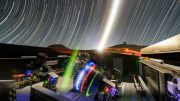

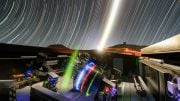
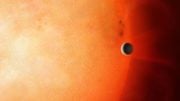
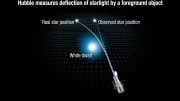
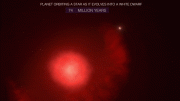
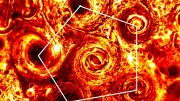
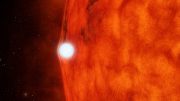
Be the first to comment on "Next Generation Transit Survey Finds its First Planet, NGTS-1b"